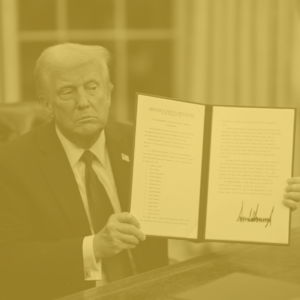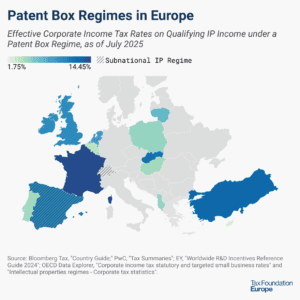
All Related Articles

The Three Basic Tax Types
The better you understand taxes, the better equipped you are to make decisions about them. All taxes can be divided into three basic types: taxes on what you buy, taxes on what you earn, and taxes on what you own.

The Truth About Tariffs—Fact-Checking Trump’s Trade Claims
Do tariffs really level the playing field, or are they just bad economics? In this emergency episode, we fact-check the Trump administration’s claims that retaliatory tariffs make trade fairer.

The UK’s Tax Battles, Part One: How We Got Here
This episode of The Deduction is part one in our ongoing coverage of the UK’s tax battles. Jesse chats with Tom Clougherty, research director and head of tax at the Centre for Policy Studies in London about what went down in the UK this fall: from the leadership elections to the countless U-turns the new prime minister has made to try and reform the country’s tax code.

The Wayfair Sales Tax Ruling, Five Years Later
It’s the 5th anniversary of the groundbreaking Wayfair Supreme Court decision–a ruling that marked a new era of sales tax collection and changed how we think about taxation in the digital age.

The Weird Way Taxes Impact Behavior
Learn about how taxes can influence human behavior through the power of incentives. See how different tax policies have impacted everything around us, including the buildings we live in, the cars we drive, and even what we eat and wear. Gain a deeper appreciation for the importance of designing tax policies that encourage positive economic behaviors.

The Woes of Temporary Tax Policy
From the Tax Cuts and Jobs Act in 2017 to the Inflation Reduction Act, signed into law just this summer, lawmakers across the political spectrum are often tempted to implement temporary tax reforms. Garrett Watson joins Jesse to discuss the pros and cons of writing tax laws that have an end date and why we find ourselves having a debate at the end of each year about so many temporary provisions.

The World of Excise Taxation
Marijuana, betting, soda, ride-sharing—over the last decade, the excise tax family has grown significantly and it’s more crucial than ever that lawmakers, businesses, and consumers understand the possibilities and, more importantly, limitations of excise tax application.

Trump and Biden’s Tariff Tango
Tariffs are a hot topic this election cycle for both President Biden and former President Trump. But why are tariffs so popular despite their economic downsides?

Trump’s Tariff War Returns
Are tariffs making everything more expensive? With Trump’s new tariff plans hitting $1.1 trillion in imports—far more than his first term—prices could rise for businesses and consumers alike.

Understanding Tariffs
Depending on your perspective, tariffs are either a great way to tax countries like China for their protectionist trade policies or they are a big reason why all those imported toys, clothing and holiday gifts cost more than you expected. You’ll learn what tariffs are, how they function, and how they can impact the domestic U.S. economy.






